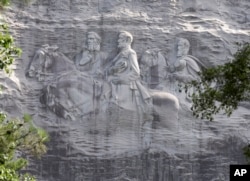General Robert E. Lee, who led the Confederate Army during the United States Civil War, died in 1870. But in some ways, he lives today.
Americans are having a heated debate about whether to remove statues of Lee and other Confederate heroes from public places. In comments to the press on Tuesday, President Donald Trump said that by removing them, “You’re changing history. You’re changing culture.”
Trump did not explain what he meant by “culture.” But a recent poll of Americans found that 54% of Americans overall see Confederate statues as symbols of Southern pride.
The poll also found that about a quarter of Americans see the statues as a symbol of something else: racism.
Unlike any other country in the world…
The U.S. has at least 700 statues honoring the Confederacy across the country. They recall the U.S. Civil War of the 1860s.
In that conflict, 11 Southern slave-holding states withdrew from the Union. They formed their own government, called the Confederacy.
The Confederacy protected the rights of states to make their own laws, including those permitting slavery. At the time, 90 percent of black people in the U.S. were enslaved.
After four years of bitter fighting, Confederate General Robert E. Lee surrendered and effectively ended the Civil War.
The Confederate states re-joined the Union. And, about three years later, the country approved an amendment to the Constitution that legally ended slavery across the country.
Minisha Sinha is a historian at the University of Connecticut. She says Americans’ monuments to the Confederacy are unusual for several reasons.
First, Sinha says, “unlike any other country in the world, the U.S. actually has statues commemorating people from the South who committed treason against the U.S. government.”
Second, she says, the Confederacy was based on the belief of white people’s superiority over black people. For example, the vice president of the Confederacy, Andrew Stephens, wrote, "Our new government is founded upon … the great truth that the negro is not equal to the white man; that slavery subordination to the superior race is his natural and normal condition.”
As a result, says Sinha, Confederate heroes are not innocuous markers of American history.
“In fact, these figures represent a short-lived nation that was in rebellion against the United States, and that really stood for slavery and white supremacy.”
The Confederacy in the 20th century
But in the decades following the Civil War, some Americans’ perceptions of the Confederacy changed.
In 1915, a woman writes why she has joined an organization called the Daughters of the Confederacy. The writer describes a Southern culture, or way of life, characterized by bravery, honor, glory, and lady-like behavior. She says she is honoring her ancestor’s struggle in the Civil War.
She writes, “I do not consider the cause which he held so dear to be lost or forgotten. Rather, I am extremely proud of the fact that he was a part of it and was numbered among some of the greatest and bravest men which any such cause ever produced.”
Historian James Oliver Horton was a professor at George Washington University. He says historians in the later 20th century find overwhelming evidence that slavery really was a central cause of the Civil War.
In his essay The Civil War Remembered, Horton writes, “When southern whites in the 19th century spoke of the ‘southern way of life,’ they referred to a way of life founded on white supremacy and supported by the institution of slavery.”
Most Confederate monuments were not built after the Civil War
Modern historians find additional evidence that public statues of Confederate forces are more complicated than they might appear.
Notably, most Confederate monuments were not built immediately after the Civil War. The majorities were built at the turn of the 20th century and in the 1950s, when some white Americans were protesting strongly against increasing the civil rights of black Americans.
Historian April Holm at the University of Mississippi writes, “Most are not ‘Confederate-era’ monuments, as I have seen them called. These are primarily Jim Crow-era monuments. “Jim Crow” refers to laws and sanctions aimed at ethnic discrimination, especially against African-Americans. As an era, it lasted from the late 1800s to the mid-1950s.
This dispute is not new
The dispute over whether to remove Confederate monuments from public places has flared up many times in Americans’ public conversation.
In 2015, lawmakers in South Carolina – which had been the first state to withdraw from the Union in 1860 – voted to remove the Confederate battle flag from its Capitol grounds.
The decision followed the shooting of nine African-American people in a South Carolina church by a young white man. The shooter said he was motivated by his anger at African-Americans.
Polls this week suggest very few Americans who want to preserve Confederate memorials support extreme racist views.
One woman who rallied last weekend to keep the statue of Robert E. Lee in a public park told the New York Times that she and her friends were simply “gun-loving defenders of free speech … who had no interest in standing with Nazis or white supremacists.”
What might be more important in America's different perceptions of the Confederate monuments is political affiliation. Democrats are about evenly divided on keeping or removing the statues.
But a majority of Republicans – the party to which President Donald Trump belongs – strongly favors keeping the statues in place.
Interestingly, one opponent of memorials to the Confederacy is Robert E. Lee himself. Several years after the Civil War, he warned against raising monuments to the Confederacy. He wrote, "I think it wiser not to keep open the sores of war but to follow the examples of those nations who endeavored to obliterate the marks of civil strife.”
I'm Caty Weaver.
Kelly Jean Kelly wrote this story for Learning English. Hai Do was the editor.
________________________________________________________________
Words in This Story
negro - n. old fashioned term to describe a black American. It is no longer used in modern American English.
innocuous - adj. not likely to offend
perception - n. the way you think about or understand something
flare up - v. to happen suddenly and unexpectedly













